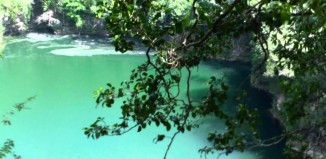A full day to enjoy in Campeche
The oldest city in the Yucatan Peninsula
Peaceful and colorful, like its 1,600 colonial houses. From the Mayan ruins of Edzná to Sihoplaya, a route through Campeche, the oldest city in the Yucatan Peninsula. A Mexican secret among walls.
Here is a complete itinerary to spend an unforgettable day in Campeche:
The people from Campeche are known as ?Campechanos,? a word that took on a new meaning because of them, now used in Spanish-speaking countries to describe a friendly, cheerful person. It would seem they have to steal visitors from their nearby neighbors Cancun and the Riviera Maya, but they have an excess of what it takes: Mayan ruins, immense beaches, virgin jungle, mysterious cenotes, magical towns and a capital that, in addition to being a World Heritage Site, is one of the most beautiful colonial cities in the Americas. It?s the oldest in the Yucatan, founded in 1517 as Salamanca de Campeche, a name that was changed 20 years later for the current (and official) San Francisco de Campeche. It still has its city walls, a rare sight in Mexico. Within, a town with 1,600 houses beautifully restored, vivid colors, a tranquil ?Campechano? atmosphere, no tourist stress and a national record for safety make Campeche a difficult secret to keep.
9.00 Chaya?
Visiting the market (1) early in the morning will convince you you?re in another world. Few are familiar with the fruits with exotic names and appearances, like chaya (which is used in both soup and a popular drink) or fish never seen before. But, above all, the market is a mix of unique faces and personalities, like ?el Chino? (who?s Korean), captured in a mural by the entrance by an American graffiti artist. Calm Mexicans nose around in El Expreso and el Hoy for the day?s gossip. The market is next to a walled hexagon of Old Campeche: an enclosure finished in 1704 with two doors and seven fortifications. The continual pirate attacks (Dutch, Portuguese, English and French) made the subsequent building of two forts on neighboring hilly paths.
10.00 The masks of Calakmul
You can start at the forts because both house a museum. San Jose fort (2), closer to the market, with a moat and drawbridge, contains artillery, weapons and model ships. To the west, San Miguel fort (3) has stelae and pieces from the Mayan period, including the jade masks from the Calakmul site. Returning to the town and the market, the bulwarks (pentagon-shaped structures built every three kilometers to reinforce the wall) house small museums. The one at San Pedro fort, together with the San Juan de Dios church, is the epitome of colonial religious, military and civil architecture. Farther along, the bulwarks at San Francisco and San Juan defend the Puerta de Tierra. Following the perimeter, the bulwark at Santa Rosa holds a museum featuring local painters. At San Carlos you?ll find a small museum about the colonial city. Continue along the part of the wall that runs to the Puerta del Mar and the Soledad bulwark houses Mayan stelae and other remnants. End the circuit at the Santiago bulwark, which hides a small botanical garden.
12.00 Visit the giant ceibas
You?ve gotten close to the heart of Old Campeche, Independence park (4). The place where everything happens, around the central kiosk: music, coffee, trees and giant ceiba trees, pigeons harassed by children, street vendors selling jipijapa hats, benches coveted by the lazy and in love alike. Across from the plaza-park is the cathedral, more spectacular outside than in, with its small museum. On the other side is the old city hall, today a library from whose balconies, equipped with powerful speakers, someone reads poems out loud in the afternoons. On the other side you?ll find the wooden tourist streetcar, which leaves at various times during the day for a tour around the colonial grid?a checkerboard 5 blocks by 9 blocks, with low houses in brilliant colors, doorways, balconies, gates and notable buildings like Casa Nº 6(5) (a café-bookstore and cultural center), San Francisquito (6) (with a cloister and baroque altars in its chapel) and the ex-church of San José, covered in Talavera tiles and an elegant lighthouse in its tower. 2.00 pm Panuchos, mojarras and huaraches If it?s time for lunch and you find yourself on Calle 59, the pedestrian street that joins the Puerta de Tierra with the Puerta de Mar, try one of the recommended restaurants, like Anchor?s 59 (7), specializing in seafood. On the parallel street, Calle 57, El Bastión (8), with its sophisticated atmosphere, might be a better fit for dinner. Around the corner, across from the Puerta de Mar, Marganzo (9) is the ideal place to try regional traditional dishes: panuchos, mojarras, huaraches, cochinita pibil, crab quesadillas. You can also try traditional cuisine in Casa Vieja (10). A very popular place for dinner are the porticos at San Francisco church (11).
4.00 pm Acapulquito
Take advantage of the early evening to enjoy the ocean. There?s no beach in the city, the closest (Bonita, San Lorenzo) are not the best. Seybaplaya (12) is nicer (the fact that the locals call it ?Little Acapulco? says it all). Even better is Sihoplaya (13), just 30 minutes from the center of town. An old sisal hacienda from the 19th century is now the comfortable Tucán Siho-Playa hotel (you can also find great food here). From here in a half hour you can get to Edzná (14), which might be the most visited Mayan site in the state. It reached its peak between the years 600 and1200, and around 200 structures (only 20 have been uncovered) have been detected. In its Great Acropolis rises the Temple of Five Floors, related to the architecture at neighboring Tikal. At night they have a light and sound show.
8.00 pm Movie night
In Campeche?s Puerta de Tierra you can see a similar show, with very committed actors who bring the city?s history to life. Campechanos are very lively people. In some bars in the historic center they improvise music shows with guitars, harps and drums. But relaxing is still important. Next to the Puerta de Tierra, a group of 17th century houses comprise the Hacienda Puerta Campeche (15), managed by the Starwood chain, whose patios and pools are full of candles and silence. Right on Calle 59, the Casa Don Gustavo (16), inside a 18th century building, is furnished with historical pieces, among which is a bed used by Emperor Maximilian I and his wife, Carlota. Steps from the cathedral, the Plaza Colonial (17) (Calle 10, 5) is another boutique hotel, related to the bigger Hotel Plaza (18) (Calle 10, 126). If you?re looking for total relaxation, about four miles on the Uayamon-China-Edzná highway is Hacienda Uayamon (19), a place that seems straight out of a movie with luxury suites surrounded by ceibas and tropical vegetation, pools and noble ruins converted into a spa.
Source: El País
State
Campeche







